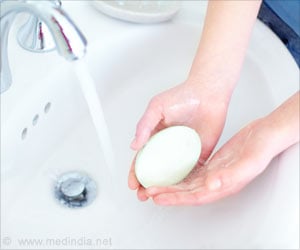Healthcare-associated infections contribute to significant rates of illness and mortality, with an estimated 5 to 10% percent of patients admitted to hospitals.

‘On average, healthcare providers clean their hands less than half of the times they should. On any given day, about one in 25 hospital patients has at least one healthcare-associated infection.’





This is according to a new study published in the August issue of the American Journal of Infection Control, the official journal of the Association for Professionals in Infection Control and Epidemiology (APIC). Healthcare-associated infections (HAIs) contribute to significant rates of illness and mortality, with an estimated five to ten percent of patients admitted to acute care hospitals in the United States acquiring an HAI. Most HAIs are preventable, and the single most effective measure to reduce HAIs is hand hygiene.
Allison Lastinger, MD, of the West Virginia University (WVU) School of Medicine, led a multidisciplinary research team that performed a cross-sectional survey of parents of hospitalized children, adult patients, and primary care physicians at the WVU Medicine J.W. Ruby Memorial Hospital, a 645-bed tertiary care teaching hospital in Morgantown, WV. Using an anonymous, self-administered questionnaire, the multidisciplinary research team -- which included Kayeromi Gomez, PhD, of the WVU School of Public Health, Ellen Manegold, BA, of the WVU Department of Psychology, and Rashida Khakoo, MD, of the WVU School of Medicine -- examined their attitudes toward a new patient empowerment tool (PET) at the hospital. The parent and patient surveys were distributed from December 2015 to June 2016; the physician survey was distributed in November 2015.
"Patient involvement is increasingly recognized as an important component of hand hygiene improvement strategies," said Linda Greene, RN, MPS, CIC, FAPIC, 2017 APIC president. "Organizations must realize that patients and families are an important part of the healthcare team, and their involvement in hand hygiene campaigns should be encouraged."
A total of 222 adult patients and parents completed the survey (108 adult patients and 114 parents). Most adult patients (64 percent) and parents (70 percent) said the PET made them feel more in control of their care. Most parents (77 percent for physicians and 81.4 percent for nurses) and adult patients (64.8 percent for physicians and 71.2 percent for nurses) felt comfortable using the PET to remind healthcare workers to perform hand hygiene. Researchers noted, however, that parents were nearly 20 percent more likely than adult patients to speak up if a physician did not perform hand hygiene. In Ruby Memorial Hospital, hand hygiene rates increased from 48 percent in 2015 to approximately 75 percent in 2016 as a result of the hospital’s multipronged initiative to increase handwashing rates among its healthcare providers. "Forty-eight percent is pretty standard," said lead study author Dr. Lastinger, "so 75 percent is phenomenal."
Advertisement
Of the physicians who did not support patient involvement, 37 percent felt that it was not the patient’s responsibility to remind physicians to perform hand hygiene; 16 percent felt that it was embarrassing to the doctor; and 13 percent felt that it would have a negative impact on the patient-physician relationship.
Advertisement
"Based on the results of this study, patient empowerment appears to be an effective strategy to facilitate healthcare workers’ adherence to hand hygiene, but acceptance of the PET by providers remains a challenge," said Lastinger. "Barriers to hand hygiene adherence among healthcare providers should be identified and addressed."
Source-Eurekalert









